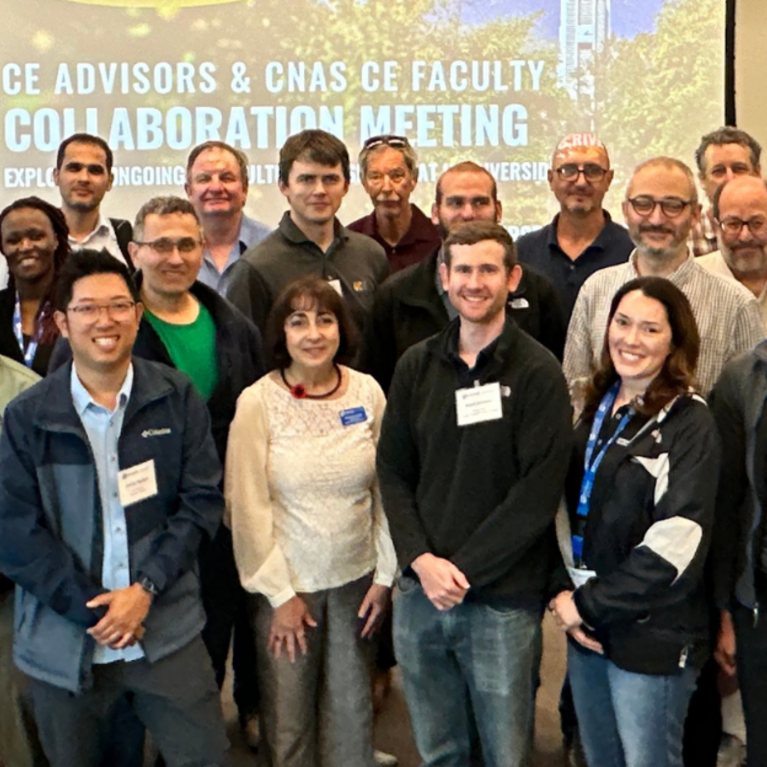Cells Across the Tree of Life Exchange ‘Text Messages’ Using RNA
QUANTA MAGAZINE - For a molecule of RNA, the world is a dangerous place. Unlike DNA, which can persist for millions of years in its remarkably stable, double-stranded form, RNA isn’t built to last — not even within the cell that made it. Unless it’s protectively tethered to a larger molecule, RNA can degrade in...
By Annie Melchor | Quanta Magazine |

CE Advisors & CE Faculty Collaboration Meeting: Exploring Ongoing Agricultural Research at UC Riverside
The University of California, Riverside (UCR) College of Natural & Agricultural Sciences (CNAS) hosted the Cooperative Extension (CE) Advisors and UCR CE Faculty Collaboration Meeting on May 23. CE advisors located in (or serving) over 14 counties across California were invited to learn about the ongoing research by UCR CE faculty to enhance collaboration between...
UC Food-Safety Specialist Tests Biosensors to Ensure Safe Produce
MORNING AG CLIPS - Ahmed El-Moghazy joined UC Agriculture and Natural Resources as a UC Cooperative Extension food safety specialist in February and is based at UC Riverside. Food safety, according to El-Moghazy, are measures that ensure food is free from harmful contaminants, prevent foodborne illnesses and is safe to eat. El-Moghazy is responsible for...
By Morning Ag Clips |
A one-shot vaccine for COVID, flu and future viruses? Researchers say it's coming
SALON - But what if it were possible to protect against COVID and the flu, and other unknown viruses that haven't yet emerged, with just one shot? If that became reality, seasonal or annual boosters would be part of the past. And what if such vaccinations didn't even require a needle? While those possibilities may...
By Nicole Karlis | Salon |
Universal vaccine may be effective against any variant of any virus
EARTH.COM - Scientists at the University of California, Riverside (UCR) has recently developed a revolutionary RNA-based strategy for a universal vaccine capable of combating any virus strain effectively and safely – even in infants and the immunocompromised. This innovative approach could transform how vaccines are developed and administered across the globe. Traditionally, vaccines are designed...
By Andrei Ionescu | Earth.com |
'One and Done': Scientists Develop Vaccine That May Fight Any Viral Strain
U.S. NEWS - Genetics-based “one-and-done” vaccines for the flu and COVID could prove more effective and easier to craft than current jabs, researchers report. These new vaccines would target viruses using a different response to infection than what is prompted by current vaccines, researchers said. “What I want to emphasize about this vaccine strategy is...
By Dennis Thompson HealthDay Reporter | U.S. News & World Report |
New ‘One-And-Done’ Vaccine Method Could Protect Infants—From Covid, Flu—With Just A Single Shot, Study Suggests
FORBES - Researchers are pitching a new vaccine method for infants that offers continued protection with just a single dose, even if the virus mutates, according to a new study that could set the stage for “universal vaccines.” The research team from the University of California, Riverside, believes because this strategy doesn’t rely on the...
By Arianna Johnson | Forbes |
A Virus May Help Save The World’s Amphibians From Extinction
FORBES - A deadly fungus that is devastating frogs and toads around the world may in fact be vulnerable to a virus that can infect it. The fungus, Batrachochytrium dendrobatidis also known as Bd or the amphibian chytrid fungus, causes chytridiomycosis in amphibians. This fungus is a pathogen that infects and destroys the skin of...
By GrrlScientist | Forbes |
Could a new virus put an end to the global amphibian pandemic?
EARTH.COM - A team of scientists led by the University of California, Riverside (UCR) may have found a potential weak point in the fight against a fungus decimating frog and toad populations across the globe. The study focused on a virus that infects the fungus responsible for the global amphibian pandemic, offering a possible avenue...
By Andrei Ionescu | Earth.com |
New virus found lurking in the genome of deadly chytrid fungus
COSMOS - There’s new hope today for the future of the globe’s amphibians which are being wiped out by a devastating disease. The fungus Batrachochytrium dendrobatidis, or Bd, causes the amphibian disease chytridiomycosis. Now, the first discovery of a virus that infects Bd has been described in a paper in the journal Current Biology, which...
By Imma Perfetto | Cosmos Magazine |
Let us help you with your search